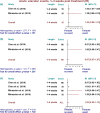Invasive dental treatment and acute vascular events: A systematic review and meta-analysis
- PMID: 35132650
- PMCID: PMC9311221
- DOI: 10.1111/jcpe.13600
Invasive dental treatment and acute vascular events: A systematic review and meta-analysis
Abstract
Background: Acute infection/inflammation increases the risk of acute vascular events (AVEs). Invasive dental treatments (IDTs) trigger short-term acute inflammation.
Purpose: The aim of this work is to critically appraise the evidence linking IDTs and AVEs.
Data sources: Six bibliographical databases were searched up to 31 August 2021. A systematic review following PRISMA guidelines was performed.
Study selection: Intervention and observational studies reporting any AVEs following IDT were included.
Data extraction: Two reviewers independently extracted data and rated the quality of studies. Data were pooled using fixed-effect, inverse variance weights analysis.
Risk of bias: Risk of bias was assessed by the Newcastle-Ottawa Quality Assessment Scale for observational studies and the Cochrane Handbook-Rob 2.0 for randomized controlled trials.
Data synthesis: In 3 out of 16 clinical studies, a total of 533,175 participants, 124,344 myocardial infarctions, and 327,804 ischaemic strokes were reported. Meta-analysis confirmed that IDT did not increase incidence ratios (IR) for combined vascular events either at 1-4 weeks (IR of 1.02, 95% CIs: 0.92 to 1.13) and at 5-8 weeks (IR of 1.04, 95% CIs: 0.97 to1.10) after treatment.
Limitations: A high level of heterogeneity (study designs and time point assessments) was found.
Conclusion: Patients who received IDT exhibited no substantial increase in vascular risk over 8 weeks post treatment.
Keywords: cardiovascular diseases; dental treatment; extraction; inflammation; periodontitis.
© 2022 The Authors. Journal of Clinical Periodontology published by John Wiley & Sons Ltd.
Conflict of interest statement
The authors declare that there is no conflict of interest.
Figures



References
-
- Aarabi, G. , Raedel, M. , Kreutzburg, T. , Hischke, S. , Debus, E. S. , Marschall, U. , Seedorf, U. , & Behrendt, C.‐A. (2020). Periodontal treatment and peripheral arterial disease severity – A retrospective analysis of health insurance claims data. VASA. Zeitschrift für Gefässkrankheiten, 49, 128–132. 10.1024/0301-1526/a000846 - DOI - PubMed
-
- Beck, J. D. , Couper, D. J. , Falkner, K. L. , Graham, S. P. , Grossi, S. G. , Gunsolley, J. C. , Madden, T. , Maupome, G. , Offenbacher, S. , Stewart, D. D. , Trevisan, M. , Van Dyke, T. E. , & Genco, R. J. (2008). The Periodontitis and Vascular Events (PAVE) pilot study: Adverse events. Journal of Periodontology, 79, 90–96. 10.1902/jop.2008.070223 - DOI - PubMed
-
- Bhagat, K. , Moss, R. , Collier, J. , & Vallance, P. (1996). Endothelial “stunning” following a brief exposure to endotoxin: A mechanism to link infection and infarction? Cardiovascular Research, 32, 822–829. - PubMed
Publication types
MeSH terms
Grants and funding
LinkOut - more resources
Full Text Sources
Medical
Research Materials

